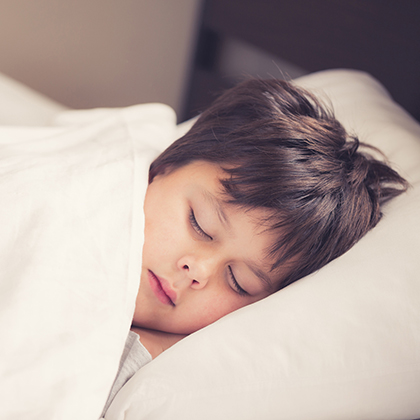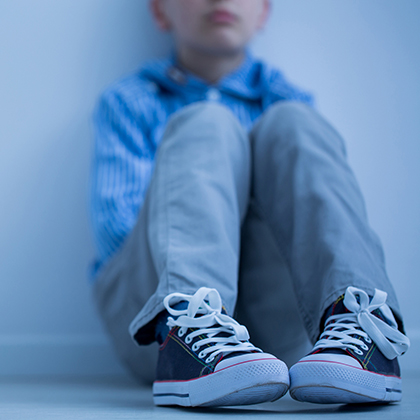
Screen-based digital technology plays a significant role in our lives these days. It comes with many benefits, of course. But there are negatives too, especially where children are concerned.
The coronavirus pandemic hasn’t helped. Even before 2020 experts were warning that children were spending too much time glued to their laptops, tablets smartphones, gaming devices and TVs. According to the UK-based charity Action for Children, too much screen time can lead to a number of problems in children (i), including:
-
Anxiety and depression
-
Obesity
-
Attention problems
-
Low self-esteem
-
Sleep problems
However when Covid-19 lockdowns, school closures and remote learning became the new normal – and when many parents relaxed their screen-time rules to keep their little ones occupied while social distancing – children’s screen time rocketed.
 US-based parental controls software company Qustodio found the amount of time children spent online increased significantly from the time the pandemic started early in 2020. The company tracks tens of thousands of devices used by children aged from four to 15 around the world, and records how often they’re being used. In the UK, Qustodio found children and families were spending twice as much time using apps and websites in January 2021 compared with January 2020, with the average time spent on apps having risen by 15 per cent a day (ii).
US-based parental controls software company Qustodio found the amount of time children spent online increased significantly from the time the pandemic started early in 2020. The company tracks tens of thousands of devices used by children aged from four to 15 around the world, and records how often they’re being used. In the UK, Qustodio found children and families were spending twice as much time using apps and websites in January 2021 compared with January 2020, with the average time spent on apps having risen by 15 per cent a day (ii).
Meanwhile in the US, the company discovered children spent, on average, 97 minutes a day on YouTube in March and April 2020, compared with 57 minutes in February and almost half that amount of time a year previously (iii).
Is there any screen time guidance?
Here in the UK, the government hasn’t issued any official guidance regarding how much time children should spend using screen-based devices. In the US, however, parents are advised to limit children two years and older to one or two hours of screen time a day – children younger than two shouldn’t be exposed to screens at all (iv).
Despite this, children in pre-pandemic America were thought to spend about three hours a day watching TV, and five to seven hours a day using screens in general (iv).
Back then it was a similar picture here in the UK too, claims a 2019 survey carried out by the Royal College of Paediatrics and Child Health (v). The survey suggests children and young people spent an average of two and a half hours on a computer, laptop or tablet, three hours on their phone and two hours watching TV every day.
Factor in the increase in screen time caused by the pandemic and it’s easy to see why health experts are concerned about how children’s growing digital habits may be harming the health of an entire generation.
Screen time and vision problems
Perhaps one of the most obvious impacts using digital screens for sustained periods of time has on children is the effect it can have on their vision. Experts believe children can experience many of the same problems caused by extensive screen use as adults, including eye discomfort, fatigue, blurred vision, headaches, dry eyes and other symptoms of eye strain (vi).
The American Academy of Ophthalmology confirms that eye health practitioners have seen an increase in the number of children experiencing dry eye and eye strain from using screens too much in recent years (vii). It also claims that shortsightedness – or myopia – is becoming more common worldwide, with the incidence of myopia having almost doubled in the US compared with 1971 and with 90 per cent of teenagers and adults in Asia affected by shortsightedness.
Indeed in 2018, a study in the academy’s medical journal, Ophthalmology, suggested that at least part of this myopia epidemic is connected with near work activities, including screen use, and that spending time outdoors in early childhood could slow the progression of shortsightedness (viii).
Then in 2020, Chinese researchers investigated how Covid-19 lockdowns affected children’s vision. They discovered shortsightedness was up to three times more common in 2020 in children aged between six and eight years old compared with figures for the previous five years (ix). According to the study’s authors, their findings suggest Covid-19 lockdowns are associated with a substantial increase in myopia for younger schoolchildren, who are more susceptible to the development of eyesight problems than older children.
How can you monitor your child’s screen time?
Even without a pandemic it can be a challenge for parents to limit their children’s screen time. However there are things you could do that may be helpful, including the following:
-
Try to set a realistic screen time limit for your child – take into account their age and how much they need to use a screen to do things like school work and homework.
-
If necessary, limit your child’s access to wi-fi connections – this may include setting up parental controls on your wi-fi router, for instance, or using a parental control app on your phone such as WiFi Blocker.
-
Use a timer to track how long they’re using their screens, as it’s easy to lose track of time when you’re busy or distracted.
-
Increase the size of the text on their screens (especially smartphones) to help prevent eye strain.
-
Try to make sure they’re using their screen-based devices correctly. According to Specsavers mobile phones should ideally be a foot away, laptops and computer screens should be two feet away and TVs10 feet away (x). Also try to make sure that the screen is slightly below their eye level, since looking up can widen the eyes and dry them out quicker.
-
Don’t allow TV watching during eating or doing homework.
-
Set a good example by limiting your screen time too, especially in front of your children.
-
Teach them the 20-20-20 rule – that is, every 20 minutes, take a break to look at something at least 20 feet away for at least 20 seconds. Also encourage them to blink often when they’re starting at a screen, as it could help prevent dry eyes.
-
Try to make sure they get plenty of play time outdoors, since studies suggest regular outside play and exercise could help prevent the development of shortsightedness in children (xi).
-
Make sure your child stays hydrated when they’re using a digital device, as water is important for eye health and may help prevent dry eyes.
-
Having a healthy, balanced diet can also help support their overall health, including their vision, so make sure they get at least five portions of fruit and vegetables every day. You may also want to consider giving them an omega-3 supplement formulated for children, since omega-3 fatty acids – including those found in oily fish – may be beneficial for their visual development (xii).
-
Book your child in for an eye test every two years from the age of three, or more often if their optician recommends it.
Screen time and sleep deprivation
The increased amount of time children spend behind screens – especially during the pandemic – is also thought to affect their sleep (and again not in a positive way). Many studies suggest that children and teenagers who spend more time with screens sleep less (xiii). However that may not just be because they’re using their phones and laptops when they should be sleeping. Many experts believe the blue light emitted by digital screens may affect children and adults because it interferes with the production of a hormone called melatonin. And when you produce less melatonin, it can be harder to get a good night’s sleep (xiv).
Some researchers – who confirm that children who spend more time on screens sleep fewer hours – also believe portable digital devices, as opposed to stationary TVs for instance, are more likely to cause sleep problems, especially among teenagers (xv). This, they say, may be because TVs aren’t as psychologically stimulating as a smartphone or tablet. Children and teens may also take their smartphones and tablets to be with them, and some may even use them throughout the night (late-night online socialising is sometimes called vamping).
Children’s sleep patterns may also have changed during the pandemic, with many staying up later than usual because of not having to get up to go to school five days a week. No school in the morning may not have been the only factor, however. One study of Chinese children who were still too young to go to school discovered they were going to sleep 57 minutes later during the pandemic than in 2018 (xvi).
What can you do?
In addition to the suggestions listed above, there are a few more strategies parents could try to help reduce sleep problems in children caused by too much screen time:
What can you do?
-
Remove screens from bedrooms at all times of the day and make sure all digital devices are turned off at least an hour before bedtime (use a reminder or an alarm when it’s time to switch off if that helps).
-
Try to make sure children do all their screen-based school work or online learning earlier in the day rather than later, to help cut back on any blue light they may be exposed to in the evening.
-
Consider establishing a routine with younger children where you read books to them at the same time every night before they go to bed. Not only can it help parents and children connect, but it may help calm children down and fall asleep more easily too.
-
Avoid letting your children watch anything too stimulating or distressing later in the day, such as a scary DVD or the news, as it could make them anxious and interfere with their sleep at night.
-
Lead by example: avoid the temptation to stay up later than usual or use your digital devices in bed, as children – especially teenagers – may notice more than you think.
Much of the advice about sleeping well that applies to adults can be useful for children too. Check out the sleep well tips in our guide to sleep and insomnia for more details.
Effects on mental health
According to the Mental Health Foundation there’s evidence to suggest children and teenagers who spend a lot of time using digital devices may have an increased risk of depression and lower wellbeing (xvii). Researchers have found, for instance, that children using their screens for more than an hour of day may experience lower psychological wellbeing, lower self-control and less emotional stability than those who stick to an hour-a-day limit, and are also more than twice as likely to be diagnosed with depression or anxiety (xviii).
Some studies, however, haven’t found any significant differences in wellbeing or mental health problems between children who use screens for the recommended amount of time and those who use them for longer, the Mental Health Foundation adds (xvii). Indeed, screen time could even have a positive impact on some children and young people, especially when it comes to their ability to communicate with friends and family. Children have even said that using social media helps them keep in touch with others, strengthen their relationships and explore new information and perspectives (xvii).
What are the symptoms of too much screen time?
While the evidence for the effects screen time has on children’s mental wellbeing is mixed, parents are themselves best placed to decide whether or not their children’s digital habits are affecting their emotional wellbeing. Some of the things you could look out for include:
-
Loneliness
-
Sadness
-
Tiredness
-
Stress
-
Nervousness
-
Being withdrawn
-
Agitation
-
Anger and aggression
-
Difficulties making and keeping friends
-
Low self-esteem
One of the keys to the problem may be the amount of time children spend behind their screens, rather than the fact that they use digital technology in the first place. If you suspect this is an issue for your family, you could try following some of the tips listed above.
Meanwhile, if your child is experiencing problems with their self-esteem, take a look at our prents’ guide to self-esteem in children. There’s also information about tackling anxiety in children here.
How to reduce the effects of screen time?
Keeping children active
Obesity and lack of fitness in children have often been linked with excessive screen time. And it’s easy to see why – after all, the more time kids spend sitting and staring at a screen, the less active they’ll probably be.
If a study by University College London experts is anything to go by, teenagers are particularly susceptible to spending more time on their screens and less time on their feet. The study found less than half (41 per cent) of 14-year-olds met recommended physical activity levels, while only 23 per cent spent two hours or less a day using screens (xix).
Experts elsewhere have noted that screen time may lead to obesity in children and teenagers because they may eat more high-calorie, low-nutrient fast foods while they’re using their screens (xx).
How can I improve my child’s physical activity?
Researchers behind a study based on World Health Organization data on screen time and physical activity in children admit it’s particularly difficult for parents to encourage children to use their screens and devices less and to exercise more instead (xxi). So what exactly can you do?
First, it’s important to be aware of how much exercise your child needs. According to the NHS, children and young people aged five to 18 should do two types of physical activity each week, namely aerobic exercise and exercises to strengthen their muscles and bones (xxii). Specifically, they should:
-
Aim for an average of at least 60 minutes of moderate physical activity every day – this is activity that makes them breathe faster and feel warmer, but not be completely out of breath (examples include walking, skateboarding, rollerblading, cycling and playground activities).
-
Take part in a variety of activities to help develop movement skills, muscles and bones (examples include running, walking, skipping, climbing, dancing, football, tennis, netball, hockey, martial arts, rugby, gymnastics and games such as tug of war).
Helping your child to take part in a variety of these and other activities is important. Other things you could do include making activity a part of daily life (taking the stairs instead of elevators, walking instead of driving to school etc) and setting aside a regular time for activity, not just for your children but for the whole family.
Being a positive role model for your family is also a great idea, so try to embrace a healthier lifestyle yourself too as often as possible. And perhaps most importantly, try to make exercise fun. That way, you and your family will want to do more of it (and spend less time behind your screens).
For more information on looking after your family’s wellbeing, check out our health library which includes a section on children’s health.
References:
-
Available online: https://services.actionforchildren.org.uk/media/1325730/fleet-parent-support-advisor-screen-time-leaflet.pdf
-
Available online: https://www.theguardian.com/world/2021/jan/22/children-health-screen-times-covid-crisis-sleep-eyesight-problems-digital-devices?CMP=Share_iOSApp_Other
-
Available online: https://www.nytimes.com/2021/01/16/health/covid-kids-tech-use.html
-
Available online: https://medlineplus.gov/ency/patientinstructions/000355.htm
-
Available online: https://www.rcpch.ac.uk/resources/health-impacts-screen-time-guide-clinicians-parents
-
Kozeis N. Impact of computer use on children’s vision. Hippokratia. 2009 Oct-Dec;13(4): 230–231. Available online: https://www.ncbi.nlm.nih.gov/pmc/articles/PMC2776336/#
-
Available online: https://www.aao.org/newsroom/news-releases/detail/is-too-much-screen-time-harming-childrens-vision
-
Po-Wen Ku. et al., The Associations between Near Visual Activity and Incident Myopia in Children. Ophthalmology. 2019 Feb ;126(2):214-220. Available online: https://www.aaojournal.org/article/S0161-6420(17)33464-4/fulltext
-
Jiaxing Wang. et al., Progression of Myopia in School-Aged Children After COVID-19 Home Confinement. JAMA Ophthalmol. 2021 Jan 14. Available online: https://jamanetwork.com/journals/jamaophthalmology/fullarticle/2774808
-
Available online: https://www.specsavers.co.uk/childrens-eyecare/screen-time-for-kids-impacts-and-advice
-
Mingguang He. et al., Effect of Time Spent Outdoors at School on the Development of Myopia Among Children in China: A Randomized Clinical Trial. JAMA 2015 Sep 15;314(11):1142-8. Available online: https://jamanetwork.com/journals/jama/fullarticle/2441261
-
Gonzales . FE., Baez RV., In Time: Importance of omega 3 in children’s nutrition. Rev Paul Pediatr. 2017 Jan-Mar;35(1): 3–4. Available online: https://www.ncbi.nlm.nih.gov/pmc/articles/PMC5417803/
-
Carter B. et al., A meta-analysis of the effect of media devices on sleep outcomes. JAMA Pediatr. 2016 Dec 1;170(12): 1202–1208. Available online: https://jamanetwork.com/journals/jamapediatrics/fullarticle/2571467
-
Zeitzer. et al., Sensitivity of the human circadian pacemaker to nocturnal light: melatonin phase resetting and suppression. J of Phys. 2000 Aug;526(3): 695 - 702. Available online: https://physoc.onlinelibrary.wiley.com/doi/full/10.1111/j.1469-7793.2000.00695.x>br />
Brainard GC. et al., Dose-response relationship between light irradiance and the suppression of plasma melatonin in human volunteers. Brain Res. 1988 Jun 28;454(1-2):212-8. Available online: https://www.ncbi.nlm.nih.gov/pubmed/3409004?dopt=Abstract -
Twenge . JM, Hisler. GC, Krizan. Z. Associations between screen time and sleep duration are primarily driven by portable electronic devices: evidence from a population-based study of U.S. children ages 0–17. Sleep Med. 2019 Apr ;56:211-218.Available online: https://www.sciencedirect.com/science/article/abs/pii/S1389945718306099
-
Zhijun Lui. et al., Sleep of preschoolers during the coronavirus disease 2019 (COVID?19) outbreak. Sleep Res. 2020 Jul 27; e13142. Available online: https://onlinelibrary.wiley.com/doi/full/10.1111/jsr.13142
-
Available online: https://www.mentalhealth.org.uk/blog/screen-time-and-childrens-mental-health-what-does-evidence-say
-
Twenge . JM., Campbell WK., Associations between screen time and lower psychological well-being among children and adolescents: Evidence from a population-based study. Prev Med Rep. 2018 Dec ;12: 271–283. Available online: https://www.ncbi.nlm.nih.gov/pmc/articles/PMC6214874/
-
Pearson. N, Sherar. LB, Hamer. M. Prevalence and Correlates of Meeting Sleep, Screen-Time, and Physical Activity Guidelines Among Adolescents in the United Kingdom. JAMA Pediatr. 2019;173(10):993-994.Available online: https://jamanetwork.com/journals/jamapediatrics/fullarticle/2748680
-
Robinson TN. et al., Screen Media Exposure and Obesity in Children and Adolescents. Pediatrics. 2017 Nov ;140(Suppl 2): S97–S101. Available online: https://www.ncbi.nlm.nih.gov/pmc/articles/PMC5769928/
-
Available online: https://www.nhs.uk/live-well/exercise/physical-activity-guidelines-children-and-young-people/
Related Posts
Disclaimer: The information presented by Nature's Best is for informational purposes only. It is based on scientific studies (human, animal, or in vitro), clinical experience, or traditional usage as cited in each article. The results reported may not necessarily occur in all individuals. Self-treatment is not recommended for life-threatening conditions that require medical treatment under a doctor's care. For many of the conditions discussed, treatment with prescription or over the counter medication is also available. Consult your doctor, practitioner, and/or pharmacist for any health problem and before using any supplements or before making any changes in prescribed medications.

Christine
Christine Morgan has been a freelance health and wellbeing journalist for almost 20 years, having written for numerous publications including the Daily Mirror, S Magazine, Top Sante, Healthy, Woman & Home, Zest, Allergy, Healthy Times and Pregnancy & Birth; she has also edited several titles such as Women’ Health, Shine’s Real Health & Beauty and All About Health.
View More



